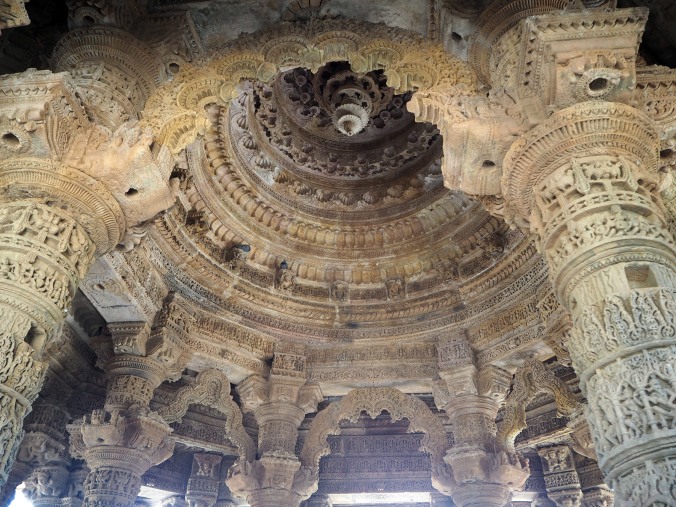We left the dust and noise and crazy traffic of the city behind on Sunday with a day trip to Patan, Gujarat’s old capital, now a rambling dusty town. But there are threee major attractions for history and textile lovers: The Sun Temple at Modhera, near Patan, Patan Patola Museum and Rani ki Van (the Queen’s Step Well).
Our 12 seater bus was due to pick us up at our hotel at 8:30, but it had mechanical problems, so they sent a 20 seater instead…. a ridiculously over-sized vehicle for three passengers!  We hadn’t yet left the city when the driver suddenly pulled over to the side of the road, picked up some grasses from a man with a table full of it and started feeding some cattle over the fence. Puzzled, I asked if these were his cows… yes – he keeps them in this paddock and stops by to hand feed them this long green fodder when he can.
We hadn’t yet left the city when the driver suddenly pulled over to the side of the road, picked up some grasses from a man with a table full of it and started feeding some cattle over the fence. Puzzled, I asked if these were his cows… yes – he keeps them in this paddock and stops by to hand feed them this long green fodder when he can.
A long, noisy, bumpy ride north through the outskirts of Ahmedabad city eventually led to a highway, and after about two hours, we pulled into the parking lot of the Sun Temple. Once through the ticket office, the temple complex is set in manicured gardens with feather-tailed squirrels darting about in the late winter sunshine. The weather has been very pleasant, hovering about 27 degrees, with cool breezes: perfect for travel and sight-seeing.
I wrote another post about the Sun Temple here >>> where you will find more information, so I will just post some pics here.

Sun Temple

Ceiling detail, Sabha Mandap at Sun Templ
Leaving the beautiful 11th century temple complex behind, we headed into Patan to visit the the Patan Patola (double kat weaving) Museum – the product of 35 generations of the Salvi family going back to the 11th century.
For those who are not familiar with double ikat weaving, the process is an extremely complicated one. First the silk warp and weft threads are tied separately with cotton thread on the sections marked out according to the proposed design. This tying process will protect the thread from taking up the dye. After dying, more sections are tied & different shades of colour are produced in this manner. It is not until all the threads on warp and weft are coloured to the desired design that the weaving begins and the final design is realised. I cannot imagine how much skill and training this process demands!

A Patan Patola sari – the pattern is created by dying both warp and weft threads in intricate patterns before weaving the two together
Because it is so specialised and difficult a technique, the Patan Patola is highly prized, with a simple sari costing about 1.5 lakh rupees, (about AU$150,000), and more as the intricacy increases, and each sari takes four to six months to weave if two people work on it five days a week.

Detail of the tied threads ready to be dyed
